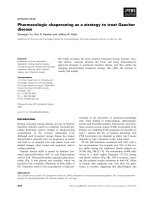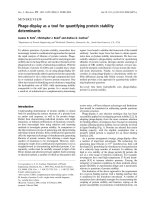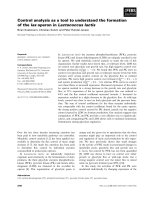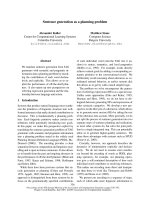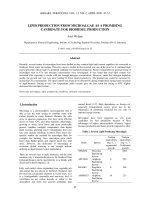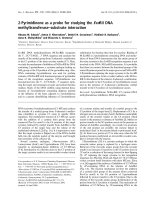Báo cáo " Using multi‐criteria analysis as a tool to select the feasible measures for sustainable development of brackish water shrimp culture in Quang Tri Province " doc
Bạn đang xem bản rút gọn của tài liệu. Xem và tải ngay bản đầy đủ của tài liệu tại đây (327.55 KB, 13 trang )
VNUJournalofScience,EarthSciences24(2008)66‐78
66
Usingmulti‐criteriaanalysisasatooltoselectthefeasible
measuresforsustainabledevelopmentofbrackishwater
shrimpcultureinQuangTriProvince
NguyenTienGiang
1,
*,TranAnhPhuong
1
,TranNgocAnh
1
,
NguyenThanhSon
1
,NguyenTruongKhoa
2
1
CollegeofScience,VNU
2
DepartmentofNaturalResourcesandEnvironmentofQuangTriProvince
Received7July2008;receivedinrevisedform23August2008
Abstract. In recent years, brackish water shrimp culture in Quang Tri Province has developed
rapidly.Thankstothisdevelopment,livesofmanylocalfarmershavebeenimproved,contributing
considerably to the poverty alleviation goal. However, together with this positive impact,
policy‐
makers and shrimp farmers are facing several issues such as spread of shrimp’s diseases, water
pollution and salinity intrusion. For the purpose of sustainable development, it is necessary to
search for and implement those measures which can solve effectively these emerging problems.
This paper presents the results on the
application of a multi‐criteria analysis method to selecting
the most feasible measures to these problems. The MCA results suggest the four most feasible
measuresandpinpointthatthecombinedoption:sedimentationreservoir& reservoirwithculture
plusimprovedfeedingandwatermanagementastheʺbestʺoption.
Keywords: Shrimp culture; Multi
‐criteria analysis; Feasible measures; Sustainable development;
QuangTriProvince.
1.Introduction
*
Quang Tri Province is located in the
CentralVietnam.Theprovinceisboundedon
the north by Quang Binh Province, on the
south by Thua Thien Hue Province, on the
westbyLaosRepublicandontheeastbythe
sea (Fig.1). The Province includes 10
administrative units: two towns
and 8
districts, in which Dong Ha is the provincial
capital.
_______
*Correspondingauthor.Tel.:84‐4‐2173940.
E‐mail:
Asregardstopography,QuangTrihasall
types of topography: mountains, hills, plains
and coastal sand dune with two main river
systems: Thach Han and Ben Hai. Lying in
the tropical monsoon region, the average
temperature of Quang Tri is ranging from
20
0
Cto25
0
C,inwhichthehighestandlowest
temperature usually happens on July and
January,respectively.
Quang Tri has a total annual rainfall of
about2000‐2700mm, buttherainfallisrather
unequally distributed over time and space.
TherainyseasonstartsinSeptember,endsin
NguyenTienGiangetal./VNUJournalofScience,EarthSciences24(2008)66‐78
67
January and accounts for 75% to 85% of the
total yearly rainfall, whereas the dry season
lasts up to 6 months, from February to July
andoccupiesonly15‐25%ofthetotalrainfall.
Fig.1.QuangTriProvince.
Quang Tri has 75 km of coastal line and
tworivermouths,namelyCuaTungandCua
Viet. In recent years, there has been a rapid
development of brackish pond area in the
province.AsshowninFig.2,thetotalareaof
brackish water shrimp culture has increased
approximately4
times,from251hain2000to
902.5 ha in 2007. According to the provincial
aquaculture development plan [6], the total
area in 2010 would be 1,889 ha, which
doubles the present’s value. Thank to this
development, the brackish pond culture has
improved remarkably the quality of life for
many
farmers in the province, contributing
positivelytothe povertyalleviation.However,
during the development process, the local
farmers and authorities have been facing
someproblemssuchaswaterpollution,salinity
intrusionandthespreadofshrimp’sdiseases.
This leads to the demand for seeking and
implementing measures to solve the conflicts
between economic goal and its negative
impacts, especially in the future, when the
provincehastheplantodeveloptheaq uaculture
tobethekeysectoroflocaleconomics[6].
0
200
400
600
800
1000
1200
1400
1600
1800
2000
2000 2001 2002 2003 2004 2005 2006 2007 2010
Y
ear
Area
(
hectars
)
Fig.2.Thedevelopmentofbrackishpondareain
QuangTriProvince.
Inorder to have feasible sets of measures
fortheabove‐statedproblem,aMulti‐Criteria
Analysis (MCA) method was used and its
resultsarepresentedinthenextsections.
This paper is divided into 5 sections.
Section 1 is involved with the problem
statement. Section 2 is devoted to the
overview of the MCA methods. Section 3
describes step by step the application of the
MCA method using pair‐wise comparison
and its results to the problem of brackish
water shrimp culture in Quang Tri Province.
Subsequently, sections 4 and 5 present some
discussions, conclusions on the results and
the
researchoutlook.
2.Methodology
2.1.Frameworkformulti‐criteriaanalysis
Any decision problem can be structured
into three major phases: intelligence which
examines the existence of a problem or the
opportunity for change; design which
Quang Tri Province
NguyenTienGiangetal./VNUJournalofScience,EarthSciences24(2008)66‐78
68
determinesthealternatives;andchoicewhich
decides the best alternative [10]. MCA is an
effective tool used in a decision process. The
major elements involved in decision making
process using a MCA method can be viewed
systematicallyinaframework(Fig.3).
Fig.3.Frameworkformulti‐criteriaanalysis.
2.2.Problemdefinition
A decision problem is the difference
between the desired and existing state of the
real world. It is a gap recognized by the
stakeholders(decisionmakers,scientistsand/or
farmers). Any decision making process
beginswiththerecognitionandthedefinition
oftheproblem.Thisstageisinthe
intelligence
phase of decision making and it involves in
searching the decision environment for
conditions,obtaining,processingandexamining
therawdatatoidentifytheproblems.
2.3.Constraints
After the problem has been defined,
constraints (or boundary conditions) of this
problem have to be determined for the
followingtworeasons:
‐ The studied problems are usually
complicate,they are relatingtomany aspects
andsectors.Therefore,itisimpossibleto take
intoaccountalltheseeffectsinpractice.
‐ On the other hand, for solving a
problem,manymeasureswouldbesuggested.
Theresponsibilityofthe scientistsistoscreen
amongthese
alternativesthefeasiblemeasures
based on applicability and suitability for the
localconditions.
2.4.Evaluationcriteria
Aftertheproblemanditsconstraintshave
beendetermined,thesetofevaluationcriteria
should be designated [2]. This stage involves
specifying a comprehensive set of objectives
that reflects all concerns relevant to the
decisionproblemandmeasuresforachieving
thoseobjectives.
2.5.Criterionweights
Criteria weighting is one of the most
important steps in the decision making
process. A weight can be defined as a value
assigned to an evaluation criterion which
indicates its importance relative to other
criteria under consideration. A ssigning
weights of
importance to evaluation criteria
accounts for: (i) the changes in the range of
variation for each evaluation criterion and (ii)
the different degrees of importance being
attached to these ranges of variation [3].
Based on this general direction, a number of
methods have been developed and applied.
Each of them
has its own advantages and
disadvantages. Table 1 summarizes some
thesemethodsandtheirfeatures.
In comparison with the ranking and
rating methods, pairwise comparison and
trade‐off analysis methods both have more
preciseandobjectiveunderlyingtheory.
ProblemDefinition
Constraints
Alternatives
Pairwisecomparison
matrix
DecisionMaker’s
Preferences
DecisionMatrix
Selectfeasible
measures
CriterionWeights
EvaluationCriteria
NguyenTienGiangetal./VNUJournalofScience,EarthSciences24(2008)66‐78
69
Table1.Methodsfordeterminingcriterionweights[8,9]
Methods/Features Ranking Rating Pairwisecomparison Trade‐offanalysis
Numberofjudgments n n n(n‐1)/2 <n
Responsescale Ordinal IntervalRatioInterval
Hierarchical Possible Possible Yes Yes
Underlyingtheory NoneNone Statistical/heuristic Axiomatic/deductive
Easeofuse Veryeasy Veryeasy Easy Difficult
Trustworthiness Low High High Medium
Precision Approximations Notprecise Quiteprecise Quiteprecise
Softwareavailability Spreadsheets Spreadsheets ExpertChoice LogicalDecision
However, when it comes to the ease of
use,pairwisecomparisonismuchbetterthan
the trade‐off analysis. For these reasons,
pairwise comparison method was applied in
this study. The following paragraphs
introducethismethod.
Themethodin volvespairwisecomparisons
to create a ratio matrix. It takes pairwise
comparisons as
input and produced relative
weights as output. The pairwise comparison
methodinvolvestwomainsteps:
‐ Development of a pairwise comparison
matrix: the method uses a scale with values
range from 1 to 9. The possible values are
presentedinTable2.
Table2.Scaleforpairwisecomparison[12]
Intensityof
importance
Definition
1 Equalimportance
2 Equaltomoderatelyimportance
3 Moderateimportance
4 Moderatetostrongimportance
5 Strongimportance
6 Strongtoverystrongimportance
7 Verystrongimportance
8 Verytoextremel ystrongimportance
9 Extremeimportance
‐ Computation of the weights: the
computation of the weights involves three
steps. The first one is summation of the
values in each matrix column. Next, each
element in the matrix should be divided by
its column total (the resulting matrix is
referred to as the normalized pairwise
comparison matrix). In
the third step,
computationoftheaverageoftheelementsin
eachrowofthenormalizedmatrixshouldbe
made which includes dividing the sum of
normalized scores for each row by the
numberofcriteria.Theseaveragesprovidean
estimateoftherelativeweightsofthecriteria
beingcompared.
The
advantageofthismethodisthatonly
twocriteriahavetobeconsideredatatime, it
can be implemented in a spreadsheet
environment[3]. One of the disadvantages is
that the relative importance of evaluation
criteriaisdeterminedwithoutconsideringthe
scales on which the criteria are measured.
Another
disadvantage is the large amount of
pairwisecomparisonsifmanycriteriaexist.
2.6.Determinationofalternatives
Basedontheconstraintsandobjectivesof
the problem and the re lating sectors, the
measures or combinations of measures to
solve the problem is to be suggested. These
measures can be the ones that have
been
being applied elsewhere having features or
new technologies that are firstly considered.
Then, scores for these measures with respect
to different criteria will be assessed after
expertconsultation.
NguyenTienGiangetal./VNUJournalofScience,EarthSciences24(2008)66‐78
70
2.7.Selectionofthefeasiblemeasures
The final stage in the decision making
process is to estimate the scores for each of
the alternatives and choose the most suitable
measuresfortheobjectivesandconditionsof
the study. Two factors used to determine
these scores are scoresfor the measures with
respecttodifferentcriteriaandweightsofthe
criteria. The measures with highest scores
willbeselectedtosolvetheproblem.
3. Application of MCA to selecting feasible
measures for sustainable development of
brackishwatershrimpcultureinQuangTri
Province
3.1.Currentandfutureproblem
Duringthelastcouple
ofyears,thespread
ofshrimpdiseasesoccurredfrequentlyinthe
study area. These diseases are spread by
brackish water, which is taken in and out
withoutproperpretreatmentandposttreatment
bytheshrimpfarmers. The river water has a
tendencytobe polluteddue tothe wastewater
fromthe
shrimpfarmsandfromothersectors
suchasindustryandagriculture.
Another problem for the shrimp farmers
is to keep a decent salinity rate for growing
black tiger shrimps (Penaeus monodon). This
salinity rate changes considerably over time
because of the tidal regime. Only at certain
periods water with
the appropriate salinity
ratecanbetakeninbythefarmers.
3.2.Boundaryconditions
Thereareseveralboundaryconditionsthat
need to be mentioned related to the problems
and possible solutions of the wastewater
problemsnearshrimpponds.Theseare:
(i) Spatial boundaries: the location of the
shrimp farms has to
stay nearby the river
estuaries; The available space for a
productionpondremains0.5‐1ha.
(ii) Social boundaries: the standard of
livingforthefarmersshouldnotbelowered.
(iii) Ecological boundaries: the water
quality in the ponds should be improved to
theneededstandardsforblacktigershrimps;
Waterqualityintheriverandintheestuaries
shouldbe improved; No measuresmay have
negativeeffectsontheenvironment.
Measures suggested should meet these
boundaries,otherwisetheywillberemoved.
3.3.Objectives
Shrimp farmers want to make their
living; they need to maintain their families.
Also because of
the relative large initial
investmentcoststheyareindebtandhaveto
repaythebanksinshortterms.
The local government wants a growing
economyinQuangTri,andshrimpfarmingis
a great opportunity for the people living in
thelowerpartsoftheprovincebecauseofits
unique
brackishenvironment.
After all requirements of all factors are
taken into account, the study comes to
concludethatthe major objective for MCA is
to achieve a more stable economic
environment. In trying to achieve this goal,
sub‐goalscanbereachedlike:
+ Better water quality in the rivers
and
estuaries;
+Betterwaterqualityintheshrimpponds;
+ Better well being of farmers and their
families/thecommunities;
+Betterfunctioningofallthelandusesin
thesurroundings.
NguyenTienGiangetal./VNUJournalofScience,EarthSciences24(2008)66‐78
71
3.4.Evaluationcriteria
To choose criteria that are useful for the
multi‐criteria analysis, several aspects are
kept in mind. First of all, the relating aspects
can influence the water quality in the river,
estuaries and shrimp ponds. Secondly, the
related actors, every actor has his main
interests, which are important
to find a
measure,oracombinationofmeasuresthatis
suitable for all the actors. Thirdly, all of the
suggested criteria have to meet the demand
of boundary conditions. Based on these
requirements, the following criteria were
taken into account in order to evaluate the
effectivenessofalternatives:
‐Costs
ofimplementation:thiscriterionis
quitelogical,asitisimportantforthefarmers
andthelocalgovernmentthatameasurewill
beaffordable.
‐ Time of implementation: this is very
importantforthefarmers.Manyfarmersnow
are already in debt because of the loans they
tookfortheirinitial
investmentcosts.Forthe
localgovernmentit is also important to have
aquicksolutionfortheissuesatthefarmsas
the shrimp farming industry itself has great
potentialfordevelopment.
‐Manageabilitybyfarmers:itisimportant
thatthemeasuresarenot difficultto implement,
maintainandoperate.
‐
Economic benefits: if measures are
successfully implemented they could really
contribute to a more stable economic
environment for both local farmers and
government.
‐Effectonproduction:thesurvivalrateof
shrimpswillincreasedifferentlypermeasure
or in some cases another type of culture can
beaddedtotheproduction.
‐Effectondiseases:ifpollutedsubstances
in the water are reduced to the needed or
desired water quality standards, the
occurrenceofdiseaseswilldecrease.
‐ Environmental impact: measures can be
taken at the intake or outlet of the shrimp
farms.Inthiswaytheimpactcanbedifferent
permeasure.
‐ Needed policies: depending on each
measure the government needs to apply
policies to the area affected by the measure.
This requires time‐consuming and costly
efforts.
‐ Large scale effectiveness: It is important
to see how large the influence of a measure
can be, mostly for the future planning of
aquacultureinQuangTriProvince.
3.5.Determinationofcriterionweights
When the criteria have been selected, the
next step is to determine weights for these
criteria based on the importance of each
criterion. Because the main objective of the
study is to create a more stable economic
environmentforthe
farmersandgovernment,
the two criteria, which are economic profit
and environmental impact, will be assigned
the highest weight. Other objectives are cost
and time of implementation, effect on
diseases. Finally, the impact and area of
impact are important for the aquaculture,
agriculture, industries and other land users.
Based on these
criteria and the preference
order,thefollowingparagraphdiscusseshow
to determine these weights by the pairwise
comparisonmethod:
Establishmentofpairwisecomparisonmatrix:
Eachpairofcriteriawastakenfromthesetof
the criteria and compare with each other.
Experts’ consultation was used for the
relative important level
of one criterion
between a pair of criteria based on
information in Table 2. The exercise was
repeated for all the pairs of criteria and the
resultispresentedinTable3.
NguyenTienGiangetal./VNUJournalofScience,EarthSciences24(2008)66‐78
72
Table3.Thepairwisecomparisonmatrix
Criteria A B C D E F G H I
A:Economicbenefits 1.00 2.00 3.00 1.00 4.00 5.00 5.00 6.00 7.00
B:Costsofimplementation 0.50 1.00 2.00 0.50 3.00 4.00 4.00 5.00 6.00
C:Timeofimplementation 0.33 0.50 1.00 0.33 2.00 3.00 3.00 4.00 5.00
D:Environmentalimpact 1.00 2.00 3.00 1.00 4.00 5.00 5.00 6.00 7.00
E:Effectondiseases 0.25 0.33 0.50 0.25 1.00 2.00 2.00 3.00 4.00
F:Manageabilitybyfarmers 0.20 0.25 0.33 0.20 0.50 1.00 1.00 2.00 3.00
G:Largescaleeffectiveness 0.20 0.25 0.33 0.20 0.50 1.00 1.00 2.00 3.00
H:Effectonproduction 0.17 0.20 0.25 0.17 0.33 0.50 0.50 1.00 2.00
I:Neededpolicies 0.14 0.17 0.20 0.14 0.25 0.33 0.33 0.50
1.00
Sum 3.79 6.70 10.62 3.79 15.58 21.83 21.83 29.50 38.00
Table4.Thestandardizedpairwisecomparisonmatrix
Criteria A B C D E F G H I Weight
A:Economicbenefits 0.26 0.30 0.28 0.26 0.26 0.23 0.23 0.20 0.18 0.25
B:Costsofimplementation 0.13 0.15 0.19 0.13 0.19 0.18 0.18 0.17 0.16 0.17
C:Timeofimplementation 0.09 0.07 0.09 0.09 0.13 0.14 0.14 0.14 0.13 0.11
D:Environmentalimpact 0.26 0.30 0.28 0.26 0.26 0.23 0.23 0.20 0.18 0.25
E:Effectondiseases 0.07 0.05 0.05 0.07 0.06 0.09
0.09 0.10 0.11 0.08
F:Manageabilitybyfarmers 0.05 0.04 0.03 0.05 0.03 0.05 0.05 0.07 0.08 0.05
G:Largescaleeffectiveness 0.05 0.04 0.03 0.05 0.03 0.05 0.05 0.07 0.08 0.05
H:Effectonproduction 0.04 0.03 0.02 0.04 0.02 0.02 0.02 0.03 0.05 0.03
I:Neededpolicies 0.04 0.02 0.02 0.04 0.02 0.02 0.02 0.02 0.03 0.02
Establishment of standardized comparison
matrix: This matrix can be estimated by
dividing each element in the pairwise
comparison matrix by its column total. The
resultispresentedinTable4.
Computation of criterion weights: Weights
of each of the criteria were determined by
computing the average of the elements in
eachrowofthenormalizedmatrix.Theresult
isshowninthelastcolumnofTable4.
3.6. Measures for Quang Tri’s brackish water
shrimpculture
To solve the problems relating to Quang
Tri’sbrackishwatershrimpculture,thestudy
considers those measures that are being used
inthetarget
areasaswellasforeigncountries,
such as Indonesia, China, Bangladesh,
Germany, Mexico, Colombia, USA. Some of
themareintroducedasfollows.
3.6.1.Structuralmeasures
A1:Polyculture
In the shrimp farm, the first crop will
remain the same as before, but the second
crop(JulytoOctober)willbeusedto
produce
not only shrimp but also other culture, like
oysters, crabs, mussels, fish, etc. In doing so,
therewill be two profits:the nutrients in the
water stemming from the first crop will be
reused in the second crop, and the farmers
NguyenTienGiangetal./VNUJournalofScience,EarthSciences24(2008)66‐78
73
will have more economic certainty, because
theycanbetontwodifferenthorses.Someof
thesemi‐intensiveshrimpfarmshavealready
used the polyculture method, with fish and
rice.
A2:Bio‐filter
‐ A2.1: Mangrove filter. This measure has
been already conducted by combining the
shrimp farming industry with the
placing of
mangroves in Colombia [1]. The cost of the
measure is around 100,000 USD (1995 price)
for 120 ha of mangroves and 200 ha of
productionpondarea[1].Constructionofthe
measure cost about 100,000 USD, which is
very cheap in comparison with the cost of a
constructed wetland
as proposed by
Schwartz and Boyd [1]. The most significant
benefitofthesystem,followedbyGautier, is
the BOD and TSS removal from pond
effluent. Another potential financial benefit
of the recirculation system is the possible
prevention of blue‐green algae bloom in the
estuary, which may cause an
off‐flavor to
developinshrimp.
‐ A2.2: Wetland. A wetland also can be a
solutiontoQuangTriProvince.The wetland
islocatedneartheshrimppondsandconsists
ofsoilwithacertainslopeandobstaclesinit,
so that water will flow through in a certain
direction. In
this way the water gets cleaned
before it reaches the discharge channel [11].
The costs of a constructed wetland depend
on the size of the wetland needed, which on
itself depends on the amount of flowing
wastewater. The advantages of the
constructed wetlands are that they can be
very effective in
improving water quality in
the downstream waters. They also are
effective in removing or stabilizing
sediments, heavy metals and organic
contaminants.
‐ A2.3: Sedimentation reservoir + reservoir
with culture (oysters, crabs). This system
includestwobasins:asedimentationbasinto
settlethesuspendedsubstancesinthewater;
and a basin with
bacteria, or other cultures
like oysters, mussels or crabs, to remove
certain nutrients (Fig. 4). The cost of this
measure is about 900 USD for 0.5 ha of
reservoir.
Fig.4.Ahypotheticalexampleofproductionponds
withsedimentationandculturereservoirs[4].
3.6.2.Non‐structuralmeasures
B1: Improved feeding management
(appropriatefeeding,lessantibiotics)
The major problems with Nutrients,
Phosphates and BOD are mainly caused by
feeding the shrimps more than they can eat
and giving them too many antibiotics. The
excess of these substances will remain in the
water and will
also get in the sludge on the
bottomoftheshrimpponds.Byreducingthe
feeding and the antibiotics, less substances
willgetintothewastewater.
B2:Betterwatermanagement. Reducingthe
numberoftimesthatwateristakeninshould
have a positive effect on the amount of
pollutedwater
takeninbyfarms.Thoughnot
NguyenTienGiangetal./VNUJournalofScience,EarthSciences24(2008)66‐78
74
changing the water often enough may have
negativeeffectsonthechancesofdiseases[5].
In order to conduct effectively this measure,
thetimingofthefreshwaterintakeshouldbe
changed together with the output of
wastewater, not only from shrimp farms but
alsothewastewateroutputofindustriesand
agriculture.
Whenthesetwo eventsoccurtoo
closetoeachother,shrimpfarmswilltakein
polluted water. The pumping in and out of
salineandwastewatershouldfollowthetidal
regimescientifically.
In practice, in order to have more
effective measures, a number of alternatives
(especially the non‐structural) are usually
implemented simultaneously. Based on the
QuangTri’slocal conditions andthefeasibility
of alternatives, 10 combinations below were
takenintoaccountintheMCAprocess:
A1+A2.3:Polyculture+Sedimentreservoir
&reservoirwithculture.
A1 + B1: Polyculture + Improved feeding
management.
A1 + B2: Polyculture + Better
water
management.
A1+B1+B2:Polyculture+Improvedfeeding
management+Betterwatermanagement.
A2.1+A2.3:Mangrovefilter+Sedimentation
reservoir&reservoirwithculture.
A2.1 + B1: Mangrove filter + Improved
feedingmanagement.
A2.2 + A2.3: Wetland + Sedimentation
reservoir&reservoirwithculture.
A2.2 +
B1: Wetland + Improved feeding
management.
A2.3 + B1: Sedimentation reservoir &
reservoir with culture + Improved feeding
management.
A2.3+B1+B2:Sedimentationreservoir&
reservoir with culture + Improved feeding
management+Betterwatermanagement
Inordertoscoreforeachofthemeasures
with the criteria, the
meaning of the impact
levels of measures on the criteria should be
defined.Themeaninglevelsareasfollows:
Costs of implementation: The lower the
scorethebetter.
Time of implementation: The lower the
amountthebetter.
Manageability by farmers: The easier the
better.
Economicbenefits:Thehigher
thebetter.
Effect on production: The higher the effect
thebetter.
Effectondiseases:Thehighertheeffectthe
better.
Environmentalimpact:Thehigherthebetter .
Needed policies: The less the amount of
policies needed (or guidance by the
government)thebetter.
Large scale effectiveness: The higher
the
scalethebetter
Basedonthesemeaning,theimpactlevels
and scores of the suggested measures for
eachofthecriteriashouldbeassessed.
The cost of implementation criterion:
amongmeasures,themeasurewiththehighest
andlowest cost will get the scoreof0and1,
respectively. The others
will be interpolated
fromthelowestandhighestcost.
The time of implementation criterion: if
theimplementingtimeofameasureislonger
than 4 months, equal to 2‐3 months and
shorterthan2months, itsscore is 0, 0.5, and
1,respectively.
Othercriteria:thisstudyevaluatesimpact
of the measures in 3 levels: hard/medium/
easy or high/medium/low with 3 respective
standardizedscoreof0,0.5,and1.
The standardized scores for different
criteriaareshowninTable5.
Based on the standardization scoring
card, the study has consulted experts in the
some of related sectors, local authorities and
residents about the impact level of measures
on each of the criteria. These evaluation
resultsareshowninTable6.
NguyenTienGiangetal./VNUJournalofScience,EarthSciences24(2008)66‐78
75
Table5.Standardizationscoringcard
Criteria Levels Standardization
Costsofimplementation high/medium/low 0/0.5/1
Timeofimplementation 4/2‐3/1 0/0.5/1
Manageabilitybyfarmers hard/medium/easy 0/0.5/1
Economicbenefits high/medium/low 1/0.5/0
Effectonproduction high/medium/low 0/0.5/1
Effectondiseases high/medium/low 1/0.5/0
Environmentalimpact high/medium/low 1/0.5/0
Neededpolicies high/medium/low 0/0.5/1
Largescaleeffectiveness high/medium/low 1/0.5/0
Table6.Scoringcardofcombinationofmeasures
CombinationofMeasures
Criteria A1+A2.3 A1+B1 A1+B2 A1+B1+B2 A2.1+A2.3
Costsofimplementation est:335 est:220 est:220 est:240 est:737
Timeofimplementation 2‐3 2‐3 2‐3 2‐3 >4
Manageabilitybyfarmers medium medium medium medium medium
Economicbenefits high high high high medium
Effectonproduction high high high high medium
Effectondiseases medium medium medium medium medium
Environmentalimpact medium medium medium medium high
Needed
policies medium medium medium medium low
Largescaleeffectiveness low low low low high
CombinationofMeasures
Criteria A2.1+B1 A2.2+A2.3 A2.2+B1 A2.3+B1 A2.3+B1+B2
Costsofimplementation est:622 est:8351 est:8236 est:155 est:175
Timeofimplementation >4 >4 >4 1‐2 1‐2
Manageabilitybyfarmers medium medium medium medium medium
Economicbenefits medium medium medium medium high
Effectonproduction medium high high medium high
Effectondiseases medium high high medium medium
Environmentalimpact high high high low medium
Neededpolicies medium
medium medium high low
Largescaleeffectiveness high medium medium low low
Next, the standardized score for the cost
of implementation should be estimated so
thattheoverallevaluation can be done. First
ofall,thecostofimplementationandapplied
areas of some projects in other locations are
collected [1, 11]. The research assumes that
thecosttoestablishthesemeasuresin
Quang
Tri Province is equal to the cost in other
regions. These values, then, are divided by
theshrimppondareatogetthestandardized
cost (USD/ha). The results are presented in
Table 8. As a rule, the alternative A2.3 + B1
withlowestcost(155USD)willbeassigned
a
score of 1 and the combination A2.2 + A2.3
with highest cost (8,351 USD) will be
assigned a score of 0. The others are
NguyenTienGiangetal./VNUJournalofScience,EarthSciences24(2008)66‐78
76
interpolated from two of these values based
on their cost per hectare. The scores for the
costs of implementation corresponding to
differentmeasuresareshowninTable7.
Table7.Standardizedscoreforcostsofcombinations
Measure Standardizedcost
Standardizedscore
A1+A2.3 335 0.978
A1+B1 220 0.992
A1+B2 220 0.992
A1+B1+B2 240 0.990
A2.1+A2.3 737 0.929
A2.1+B1 622 0.943
A2.2+A2.3 8351 0.000
A2.2+B1 8236 0.014
A2.3+B1 155 1.000
A2.3+B1+B2 175 0.998
Thefinalstepinevaluatingthemeasures
is to determine the weights for the
alternatives.Byreferringtothe standardized
scores in Tables 5 and 7, and scoringcard of
combinations in Table 6, the scores of
alternatives corresponding with different
criteria are shown in Table 8. From these
scores
andweightsofeachofthecriteria,the
evaluation score of the alternatives is
estimatedas:
∑
=
=
n
j
jiji
wsA
1
,
inwhich,A
i
isthescoreofthei
th
measure;w
j
is the weight of the j
th
criterion and s
ij
is the
scoreofthei
th
measurewithrespecttothej
th
criterion.
Table8.FinalresultsofMCA
Criteria A1+A2.3 A1+B1 A1+B2 A1+B1+B2 A2.1+A2.3 Weight
Costsofimplementation 0.978 0.992 0.992 0.990 0.929 0.17
Timeofimplementation 0.5 0.5 0.5 0.5 0.0 0.11
Manageabilitybyfarmers 0.5 0.5 0.5 0.5 0.5 0.05
Economicbenefits 1 1 1 1 0.5 0.25
Effectonproduction 1 1 1 1 0.5 0.03
Effectondiseases 0.5 0.5 0.5 0.5 0.5 0.08
Environmentalimpact 0.5 0.5 0.5 0.5 1
0.25
Neededpolicies 0.5 0.5 0.5 0.5 1 0.02
Largescaleeffectiveness 0 0 0 0 1 0.05
Total 0.701 0.704 0.704 0.703 0.683
Criteria A2.1+B1 A2.2+A2.3 A2.2+B1 A2.3+B1 A2.3+B1+B2 Weight
Costsofimplementation 0.943 0.000 0.014 1.000 0.998 0.17
Timeofimplementation 0 0 0 1 1 0.11
Manageabilitybyfarmers 0.5 0.5 0.5 0.5 0.5 0.05
Economicbenefits 0.5 0.5 0.5 0.5 1 0.25
Effectonproduction 0.5 1 1 0.5 1 0.03
Effectondiseases 0.5 1 1 0.5 0.5 0.08
Environmentalimpact 1 1 1 0 0.5
0.25
Neededpolicies 0.5 0.5 0.5 0 1 0.02
Largescaleeffectiveness 1 0.5 0.5 0 0 0.05
Total 0.675 0.545 0.547 0.485 0.770
NguyenTienGiangetal./VNUJournalofScience,EarthSciences24(2008)66‐78
77
It can be seen from Table 8 that the
measure which has the smallest score is
option A2.3 + B1. Based on the MCA result,
the4bestcombinationsare:(1)A1+A2.3;(2)
A1 + B1; (3) A1 + B2; (4) A2.3 + B1 + B2. The
last combination
(Sedimentation reservoir &
reservoir with culture + Improved feeding
management + Better water management) is the
ʺbestʺalternativewithoverallscoreof0.770.
4.Discussions
TheapplicationresultsofMCAmethodto
theproblemofbrackishshrimppondculture
in Quang Tri suggest several points worth
discussing.
First, sustainable
development is a
relatively new concept which requires taking
both short and long term goals of multiple
stakeholders into consideration. The use of
MCAasatoolinthisproblemhelpsdecision
makers in Quang Tri Province to select the
feasible measure(s) andʺbestʺ option in a
rational manner. Particularly,
the option
“Sedimentationreservoir&reservoirwithculture
+ Improved feeding management + Better water
management” is reco mmended due to its
highest score with respect to nine criteria
(Table8).
Second, the two effective measures
mangroveandwetlandfiltershavelowscores
(Table 8) because, at present, the cost to
implement these measures is too high
comparedtoothermeasures.However,inthe
future, when the shrimp activity is invested
more by the government, they should be
considered again because their positive
impacts on the shrimp pond as well as
environment.Thisisrelatedtotheproblemof
changing management objective
over time in
adecisionmakingprocess.
Third, the present research employs
information regarding to the measure
implementing costs from literature which
stemmedfromotherabroadprojects .Theref ore,
some assessments are relatively coarse
estimation. In the future, it is necessary to
havemore precise data and awider range of
stakeholdersservingfortheassessmenttask.
5.Conclusions
This paper aims to present the results of
an application of MCA to find out the most
feasiblemea suresforsustainabledevelopment
of the brackish water shrimp culture in
QuangTriProvince.TheapplicationofMCA
includesdeterminingtheemergingproblems,
objectivesand
requirementsofrelatedfactors,
aswellasthealternativesthathavebeenused
in the study area. From that it suggests the
measurestosolvetheproblemsandapplythe
MCAapproachforselectingthemostsuitable
options.
The research determined that the
combination of measures Sedimentation
reservoir & reservoir
with culture + Improved
feeding management + Better water management
is the most suitable for the Quang Tri’s
conditionforthetimebeing.
From scientific point of view, the
complexityofenvironmentalproblemsmakes
necessarythedevelopmentandapplicationof
new tools capable of processing not only the
numerical aspects, but
also the experience of
experts and wide public participation, which
areallneededinthedecision‐makingprocess
[7].
MCA is a qualitative analysis method
which allows the use of participatory
approach in the decision making process. In
other words, with MCA, all relevant
NguyenTienGiangetal./VNUJournalofScience,EarthSciences24(2008)66‐78
78
stakeholders (farmers, scientists, decision
makers) can be involved in this process. In
doingso,theconsensusontheproblemsand
theirsolutionscanbereached.However,itis
notedthatMCAissubjectiveinitsnature.In
case the quantitative data are available,
quantitative analysis (i.e. numerical
modelling) can be used
in combination with
MCA to arrive at theʺbestʺsolution(s)in the
decisionmakingprocess.Thisisanotherpart
ofourresearch.
Acknowledgements
This paper is resulted from a project
funded by the Quang Tri Department of
Natural Resources and Environment. The
authorswould like to thank all ofthe
people
who helped us to successfully accomplish
that project. The comments of the reviewer
have improved the structure and content of
the paper. This reviewer is gratefully
acknowledged.
References
[1] D. Gautier, The integration of Mangrove and
Shrimp Farming: A case study on the Caribbean of
Colombia, World Bank, NACA, WWF and FAO
Consortium Program
on Shrimp Farming and
theEnvironment, 2002.
[2] R. L. Keeney, H. Raiffa, Decisions with multiple
objectives‐pref eren ce s andvaluetradeoffs.Cambridge
UniversityPress,Cambridge,1993.
[3] C.W. Kirkwood, Strategic decision making:
Multiobjective decision analysis with spreadsheets,
DuxburyPress,Belmont,California,1997.
[4] M. Krutwagen, Impact of shrimp pond wastewater
on estuaries and the issue
of salinity intrusion in
Quang Tri Province, Internship report, Hanoi
University of Science and Twente University,
Hanoi,2007.
[5] P.S. Leung, L.T. Tran, A.W. Fast, A logistic
regression of risk factors for disease occurrence
on Asian shrimp farms, Diseases of Aquatic
Organisms41(2000)65.
[6] Nguyen Tien Giang et
al., Impact assessment of
aquaculture on water pollution, problem of salinity
intrusion and proposed alternatives contributing to
the socio‐economic development and environmental
protection for Quang Tri Province, Final project
report,HanoiUniversityofScience,Hanoi,2007
(inVietnamese).
[7] T.G. Nguyen, J.L. De Kok, M. Titus, A new
approachtotestinganintegratedwatersystems
modelusingqualitativescenarios,Environmental
Modelling&Software22,(2007)1557.
[8] G.F. Pitz, J. McKillip, Decision analysis
for
programme evaluators, Sage Publications, Beverly
Hills,1984.
[9] P.J.H.Schoemaker, C.C. Waid, A probabilistic
dominancemeasureforbinarychoices:Analytic
aspects of a multi‐attribute random weights
model, Journal of Mathematical Psychology 32 (2)
(1988)169.
[10] H.A. Simon, The new science of management
decision,HarperandRow,
NewYork,1960.
[11] D.R.Tilley,H. Badrinarayanan,R.Rosati,andJ.
Son, Constructed wetlands as recirculation
filters in large‐scale shrimp aquaculture,
AquaculturalEngineering26(2002)81.
[12] T. L. Saaty, Multicriteria decision making: the
Analytic HierarchyProcess,VolumeI,Pittsburgh,
PA,RWSPublications,1996.
